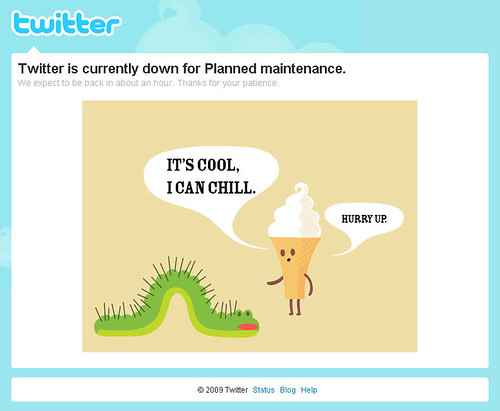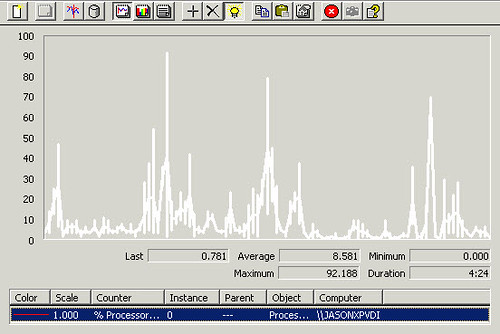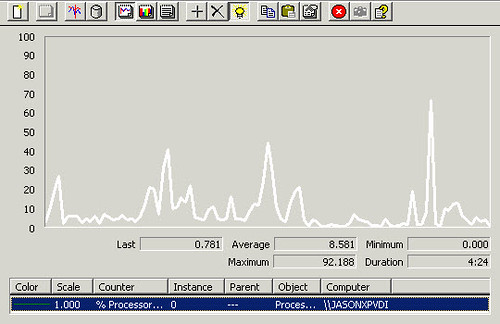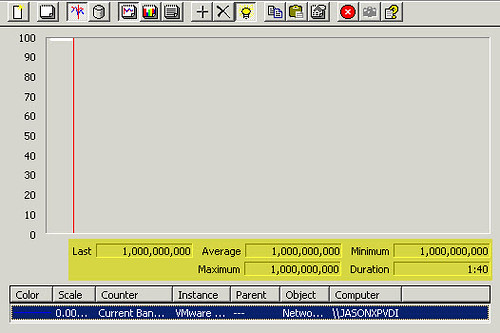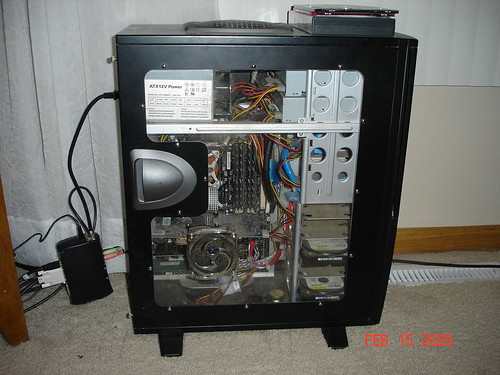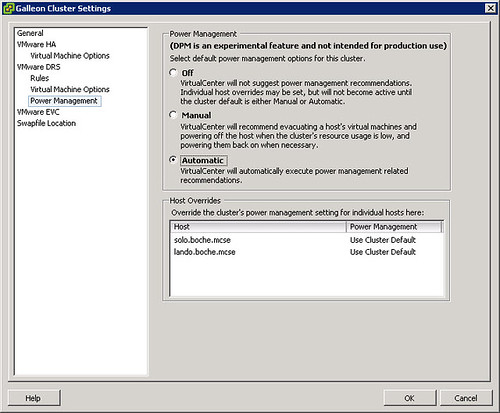I don’t see this often (in fact I’ve never seen this) so I thought it was blog worthy given the increased use of social media as a professional’s tool.
Tripwire Annoucement
February 19th, 2009 by jason No comments »Press release from Tripwire. I haven’t had time to take a look at the product yet but the announcement comes from a trustworthy and reputable source whom I respect. I look forward to seeing some commentary either on the blog here or over at vwire.com.
TRIPWIRE ANNOUNCES FREE UTILITY TO HELP MANAGE VMWARE VMOTION, LAUNCHES NEW VIRTUALIZATION COMMUNITY
Tripwire OpsCheck addresses key virtual infrastructure operational issues; vWire.com offers an opportunity for virtual infrastructure professionals to share ideas and best practices
Portland, OR – Feb. 17, 2009 – Tripwire, Inc. today announced a major new initiative for virtual infrastructure (VI) professionals, which includes Tripwire OpsCheckTM, a free tool to manage VMware VMotion, and an online community for VI administrators. Tripwire OpsCheck assesses common configuration problems that may prevent VMotion from operating properly, and provides troubleshooting tips for configuring VMotion based on Tripwire OpsCheck test results. To download Tripwire OpsCheck, go to www.vwire.com.
To further support the needs of VI professionals, Tripwire has unveiled vWire.com, an online community built around the concerns of VI professionals. Virtualization administrators, engineers and architects are invited to join the community and conversation to share best practices, network, and gain new resources and tools. For more information about the forum, visit www.vwire.com.
“Virtualization professionals are faced with unknown territory, requiring new tools to manage the complexities and risks of virtual environments,” said Dan Schoenbaum, chief operating officer of products, Tripwire. “That’s why Tripwire is committed to developing utilities specifically for virtualization, such as OpsCheck and ConfigCheck, and to creating a forum where VI professionals can share their experiences and knowledge.”
Tripwire ConfigCheck, released in 2008, provides an immediate assessment of the configurations of a VMware ESX hypervisor, comparing them against VMware hardening security guidelines, and then providing remediation instructions if any are needed. ConfigCheck is also available for free and can be downloaded at www.vwire.com.
About Tripwire, Inc.
Tripwire helps over 6,500 enterprises worldwide reduce security risk, attain compliance and increase operational efficiency across virtual and physical environments. With its industry leading configuration assessment and change auditing software solutions, IT organizations achieve and maintain configuration control. Tripwire is headquartered in Portland, Ore. with offices worldwide. http://www.tripwire.com/.
Microsoft Performance Monitor tweaks
February 17th, 2009 by jason No comments »Today I discovered the workarounds to a few issues in Microsoft Performance Monitor that have bugged me for quite a while (read: years).
Issue 1: Vertical lines are displayed in the Sysmon tool that obscure the graph view
Cause: This behavior occurs when there are more than 100 data points to be displayed in chart view.
Resolution: Microsoft KB article 283110
To enable or disable this behavior:
- Start Regedit.exe.
- Navigate to the following key:
- HKEY_CURRENT_USER\Software\Microsoft\SystemMonitor
- On the Edit menu, click New, and then click DWord Value.
- Type the following value in the Name box:
- DisplaySingleLogSampleValue
- Set the value to 1 if you do not want to view the vertical line indicators, or set the value to 0, which is the default setting, to display the vertical indicators.
Result:
Issue 2: When looking at large numbers in Performance Monitor (Windows XP), comma separators do not exist thus making it difficult to interpret large numbers.
Cause: Microsoft
Resolution: Microsoft KB article 300884
Follow these steps, and then quit Registry Editor:
- Click Start, click Run, type regedit, and then click OK.
- Locate and then click the following key in the registry:
- HKEY_CURRENT_USER\Software\Microsoft\SystemMonitor\
- On the Edit menu, point to New, and then click DWORD Value.
- Type DisplayThousandsSeparator, and then press ENTER.
- On the Edit menu, click Modify.
- Type 1, and then click OK.
Result:
Extra credit: Check out Microsoft KB article 281884 for one additional tweak that deals with viewing PIDs in Performance Monitor counters.
Putting some money where my VMware mouth is
February 15th, 2009 by jason No comments »I came home this afternoon from a Valentines Day wedding in North Dakota to find that my one and only workstation in the house (other than the work laptop) had a belated Valentines Day present for me: It would no longer boot up. No Windows. No POST. No video signal. No beep codes.
I was feeling adventurous and I needed a relatively quick and inexpensive fix. I decided to take one of the thin clients I received from Chip PC via VMworld 2008 plus a freshly deployed Windows XP template on the Virtual Infrastructure and promote this VDI solution to main household workstation status for the next few weeks. The timing on this could not have been better. The upcoming Minnesota VMUG on Wednesday March 11th is going to be VDI focused. I guess I’ll have more to contribute at that meeting than I had originally planned on. With any luck, Chip PC will be in attendance and we can discuss some things.
The thin client: Chip PC Xtreme PC NG-6600 (model: EX6600N, part number: CPN04209).
Specs:
- RMI – Alchemy Au 1550, 500MHz RISC processor (equivalent to 1.2GHz x86 TC processors)
- 128MB DDR RAM
- 64MB Disk-On-Chip with TFS
- 128-bit 3D graphics acceleration engine with separate 2x8MB display memory SDRAM
- Dual DVI ports each supporting 1920×1200 16-bit color. Supports quad displays up to 1024×768
- Audio I/O
- 4 USB 2.0 ports
- 10/100 Ethernet NIC
- Power draw: 3.5W work mode, .35W sleep mode
- OS: Enhanced Microsoft Windows CE (6.00 R2 Professional)
- Integrated applications (Plugins – note plugins are downloaded at no charge from the Chip PC website and are not, by default, embedded or included with the thin client – just enough OS concept)
- Citrix ICA
- RDP 5.2 and 6
- Internet Explorer 6.0
- VDM Client
- VDI Client
- Media Player
- VPN Client
- Ultra VNC
- Pericom (Team Talk) Terminal Emulation
- LPD Printer
- ELO Touch Screen
- Compatibility
- Citrix WinFrame, MetaFrame, and Presentation Server 4.5
- MS Windows Server 2000/2003
- MS Windows NT 4.0 – TS Edition
- VMware Virtual Desktop Interface using RDP
- Full support of both local and network printers: LPD, LPR, SMB, LPT, USB, COM
- Support for USB mass storage (thumb drives – deal breaker for me)
- Support for wireless USB NIC (not included)
- etc. etc. etc.
Truth be told, this isn’t really a promotion in the sense that I had already performed extensive testing on it. I hadn’t even taken the thing out of the box yet other than to register it for the extended warranty. I’ve had only a little experience on these devices as I have an identical unit in the lab at work which I’ve spent a total of 30 minutes on. To the best of my knowledge, this is the Cadillac unit from Chip PC.
I don’t have any fancy VDI brokering solutions here in the home lab and I’m not up to speed on VMware View so the plan is to leverage Thin Client -> RDP -> Windows XP desktop on VMware Virtual Infrastructure 3.5.
I think this is going to be a good test. A trial by fire of VDI (granted, a fairly simple variation). I spout a lot about the goodness that is VMware and now I’ll be eating some of my own dog food from the desktop workspace. I’m a power user. I’ve got my standard set of applications that I use on a regular basis and I’ve got a few hardware devices such as a flatbed scanner, iPod Shuffle, USB thumb drives, digital cameras, etc. I should know within a short period of time whether or not this will be a viable solution for the short term. Also add to the mix my wife’s career. She uses our home computer to access her servers at work on a fairly regular basis. Lastly, my wife sometimes works from home while I’m away at the office or traveling. It’s going to be critical that this solution stays up and running and continues to be viable for my wife while I’m remote and not able to provide computer support.
So where am I at now? I’ve got the VDI session patched along with my most critical applications installed to get me by in the short term: Quicken, SnagIt, network printer, and Citrix clients. I’ll install MS Office later but for now I can use the published application version of Office on my virtualized Citrix servers. I’ve been listening some Electro House on www.di.fm on the VDI and music quality is as good as it was on my PC before it died, although it doesn’t completely drive my 5.1 surround in the den. Pretty sure I’m getting 2.1 right now. Oh well, at least the sub is thumpin. Shhhh… the thin client is sleeping:
So what else? As long as I’m throwing caution to the wind, I think it’s time to take the training wheels off VMware DPM (Distributed Power Management) and see what happens in a two node cluster.
Based on the environment below, what do you think will happen? CPU load is very low, however, memory utilization is close to being over committed in a one host scenario. Will DPM kick in?
Most of my infrastructure at home is virtual including all components involving internet access both incoming and outgoing. If the blog becomes unavailable for a while in the near future, I’ll give you one guess as to what happened. 🙂
No matter what the outcome, vmwarenews.de aka Roman Haug – you are no longer welcomed to republish my blog articles. Albeit flattering, the fact that you have not even so much as asked in the first place has officially pissed me off. You publish my content as if it were your own, written by you as indicated by the “by Roman” header preceeding each duplicated post. Please remove my content from your site and refrain from syndicating my content going forward. Thank you in advance.
Update: Roman Haug has offered an apology and I believe we have reached an understanding. Thank you Roman!
VMTN: Ask the Experts session confirmed for VMworld Europe 2009
February 12th, 2009 by jason No comments »With permission to borrow much of Tom Howarth’s announcement, it gives me great pleasure to proclaim the VMTN: Ask the Experts session has been confirmed for VMworld Europe 2009. Come and see us in the community lounge during the following dates and times:
– Tuesday the 24th – 1:00 – 2:00 – community lounge
– Wednesday the 25th – 1:00 – 2:00 – community lounge
You will be able to meet VMTN community members, moderators, bloggers, and book authors and ask the most difficult questions on virtualization topics you can think of or discuss a success or issue with your environment.
I can’t guarantee we will be able to answer all questions, but we will try hard! At VMworld 2008 the VMTN panel even managed to answer a question the VMware staff at the Genius bar could not.
Panelists (in no particular order):
 Duncan Epping, – VMware Senior Consultant and owner of Yellow-Bricks
Duncan Epping, – VMware Senior Consultant and owner of Yellow-Bricks
 Gabrie van Zanten, – Owner of gabesvirtualworld
Gabrie van Zanten, – Owner of gabesvirtualworld
 Jason Boche, – VMTN Moderator, Minneapolis Area VMUG president, and owner of Boche.net
Jason Boche, – VMTN Moderator, Minneapolis Area VMUG president, and owner of Boche.net
 Alan Renouf, – Powershell Enthusiast
Alan Renouf, – Powershell Enthusiast
 Steve Beaver, – Tripwire, VMTN Moderator, Published Author, and contributor to Virtual Black Hole
Steve Beaver, – Tripwire, VMTN Moderator, Published Author, and contributor to Virtual Black Hole
 Scott Herold, – Quest, owner of VMGuru.com and accomplished Author
Scott Herold, – Quest, owner of VMGuru.com and accomplished Author
 Thomas Bryant, – Vizioncore and VMTN Moderator
Thomas Bryant, – Vizioncore and VMTN Moderator
 Wil van Antwerpen, – owner of vi-toolkit.com
Wil van Antwerpen, – owner of vi-toolkit.com
 Eric Sloof, – VMware trainer and owner of ntpro.nl
Eric Sloof, – VMware trainer and owner of ntpro.nl
 Tom Howarth, – VMTN Moderator and owner of PlanetVM
Tom Howarth, – VMTN Moderator and owner of PlanetVM
We hope to see you there! (special thanks go out to the fellows who had a hand in making this happen: Richard Garsthagen, Tom Howarth, Duncan Epping, and anyone else I may have missed.)
Virtualization Wiki launched
February 11th, 2009 by jason No comments »Rynardt Spies, proprietor of the VirtualVCP blog, has launched VI-Pedia, the Virtualization Open Wiki.
It looks like Rynardt has already begun populating the Wiki with links to VMware’s HCL information. I think the following information which I posted over at the Petri IT Knowledgebase would also prove to be useful on the Wiki:
Community-Supported Hardware/Software for VMware Infrastructure
http://www.vmware.com/resources/communitysupport/
In 2007, VMware began maintaining a web page of non-HCL hardware that works with VMware ESX. This is a list of hardware and software components that have been reported to work with VMware Infrastructure, either by the community or by the individual vendors themselves. Great for people trying to build a cheap lab out of dubious or whitebox hardware. If your hardware is not on the official VMware HCL, check this list to see if someone has reported that your particular piece of hardware works with ESX.
Additional Resources for Community-Supported Hardware/Software for VMware Infrastructure
http://www.vm-help.com/
http://www.vm-help.com/Whitebox_HCL.php
http://ultimatewhitebox.com/
http://www.vmweekly.com/articles/hardware_recommendations_to_build_cheap_esx_server/1/
http://www.mikedipetrillo.com/mikedvirtualization/2008/10/building-a-500-vmware-esxi-host.html
Thank you for putting this together Rynardt!
VMGURU to release 4 chapters of VI3 book today
February 10th, 2009 by jason No comments »Scott Herold of VMGuru.com and co-author of the book VMware Infrastructure 3: Advanced Technical Design Guide and Advanced Operations Guide has announced today the release of four of the book’s chapters in PDF format today.
I’ve read the previous version of this book a few years ago and I’m in the middle of reading the current version. I HIGHLY recommend this book. It is worth it’s weight in gold and the fact that the authors are going to begin giving it away for free to the virtualization community is baffling to me but yet at the same time it is a symbol of their generosity and commitment to providing the community with top notch technical and operations detail on VMware virtual infrastructure.
Generally speaking, many technical authors don’t make a pile of money writing books. Be sure to thank the authors Ron Oglesby, Scott Herold, and Mike Laverick for their hard work and generosity.
More information about this book can be found here and here. Stay tuned to VMGuru.com for the official release of these chapters which should happen sometime today.
